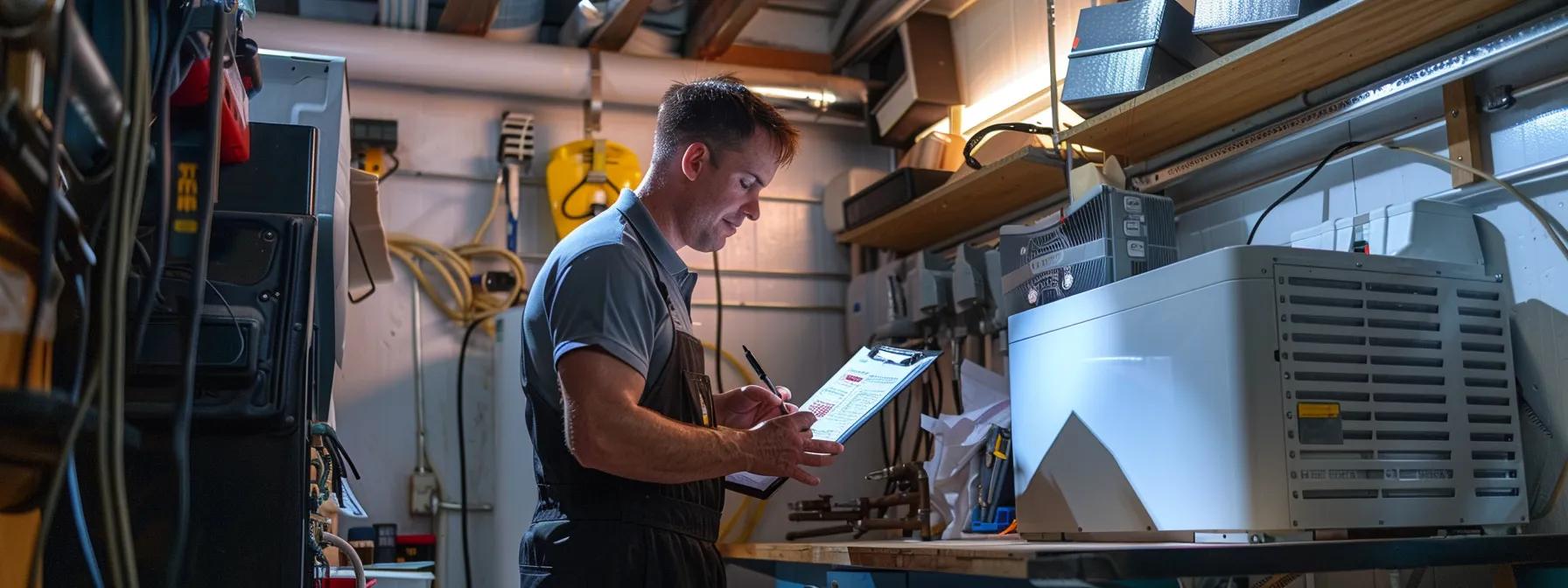AC Maintenance Guide: Keeping Your System Efficient Year-Round


AC Maintenance Guide for Every Season
Maintaining an air conditioner throughout all seasons is critical to ensure optimal performance, energy efficiency, and longevity. Regular hvac seasonal maintenance helps avoid unexpected breakdowns, maintains indoor air quality, and minimizes service calls. In homes with heatpumpsand furnaces, it is especially important to ensure all components are checked regularly. On Time Air, with over 25 years of combined expertise among its team members, advocates a proactive approach to ac care that protects your investment and ensures comfort regardless of the weather. For more details on effective care strategies, visit ontimeairhvac.com.
Understanding Your AC System for Effective Seasonal Maintenance
Understanding your air conditioningsystem is the foundation for effective seasonal maintenance. Homeowners should become familiar with the key components of an AC unit—such as the condenser, evaporator, compressor, indoor airhandler, and ductwork—to enable proper troubleshootingand informed service calldecisions. Regular HVACmaintenance improves energyefficiencyand helps prevent hazards like carbon monoxidebuildup and excessive wearon mechanical parts.
Identifying Key Components of Your Air Conditioner
Each component of your AC plays a distinct role: • The condenser releases heat from the refrigerant. • The evaporator absorbs heat. • The compressor pumps refrigerant through the system. • The air handler distributes cool air throughout the home while ducts ensure even airflow.
This understanding clarifies routine checks and helps pinpoint issues such as refrigerator pressurefluctuations or misaligned ducts.
Recognizing Signs Your AC Needs Seasonal Attention
Timely maintenance is essential when an AC shows signs of wear or inefficiency. Common indicators include: • Reduced cooling performance • Unusual noises • Higher energy bills • Visible debris or corrosion on exterior parts
These symptoms often signal problems like worn-out filters or clogged condensate drainlines. Early detection through regular inspectioncan prevent costly repairs and extend your system’s lifespan.
Tools and Supplies for Your Seasonal Air Conditioner Maintenance Guide
Having the proper tools is vital for maintenance tasks. Typical items include: • A screwdriver set • Coil cleaner • Replacement air filters • A vacuum with hose attachments • A digital thermometer
These tools assist in cleaning condensercoils, tightening loose screws, and checking for refrigerant leaks. Investing in high-quality equipment ensures efficient and effective preventive care.
Safety Precautions Before Starting Any AC Upkeep
Safety must always come first: • Always disconnect the power to avoid electrical shocks. • Wear personal protective equipment, such as gloves and safety glasses. • Do not attempt to repair internal refrigerant components without proper certification.
Following these precautions reduces injury risk and prevents damage that could void your warranty.
Spring AC Maintenance Guide: Preparing for Warmer Weather

Spring is the ideal time to ready your AC system for rising temperatures. Routine cleaning, inspection, and minor modifications help ensure efficient operation during warmer months and improve energyefficiency.
Clearing Debrisand Inspecting the Outdoor Unit
At the start of spring, inspect your outdoor condenserunit for debrislike leaves, twigs, or dirt. Use a brush or garden hose to remove debrisgently from fins and coils. Eliminating these obstructions enhances airflow, prevents overheating, and protects the condenserfrom long-term corrosiondamage.
Cleaning or Replacing Air Filters for Fresh Spring Air
Air filters accumulate dust and pollutants over winter. In spring, clean or replace these filters to maintain indoor air qualityand system efficiency. A clogged filter restricts airflow, forcing the AC to work harder, leading to higher energyconsumption and increased component wear. Regular filter maintenance is key to sustaining optimal airflow and cooling efficiency.
Checking and Cleaning Evaporatorand CondenserCoils
Over winter, moisture and dust can build up on coils, reducing heatexchange efficiency. In spring, carefully clean the evaporatorand condensercoils using a coil cleaner solution. Clean coils operate more efficiently, contributing to lower energybills and improved cooling performance.
Testing ThermostatFunctionality for Accurate Cooling
A malfunctioning thermostatcan undermine your entire maintenance effort. Test your thermostatto ensure it accurately reflects room temperature and responds promptly to cooling demands. Recalibrate or replace it if necessary to avoid inefficient cooling and energywaste. A correctly programmed thermostatis essential for maintaining comfort levels.
Examining Condensate DrainLines for Proper Flow
Blocked condensate drainlines may lead to water leakage, mold growth, or even system shutdown. In spring, inspect and clean these lines using a wet/dry vacuum or a specialized draincleaning brush. Ensuring proper drainage protects indoor air qualityand prevents water damage during humid periods.
Summer Air Conditioner Maintenance Guide: Ensuring Peak Performance
During summer, your AC system faces intense demand. Regular inspections and adjustments are crucial to maintaining efficiency, reducing operating costs, and handling prolonged high temperatures.
Monitoring AC Performance During High Temperatures
In peak summer heat, your AC runs continuously. Monitor its performance by checking for any drop in cooling output or unusual unit noises. Early signs of issues—like compressor strain or low refrigerant levels—can be addressed promptly to avoid expensive repairs.
Optimizing Airflow for Maximum Cooling Efficiency
Efficient cooling depends on optimal airflow. Ensure that both indoor and outdoor units are free from obstructions, and verify that ductwork is sealed and insulated. Techniques such as using ceiling fans and keeping the area around the outdoor unit clear help improve ventilationand reduce energyconsumption.
Regular Filter Checks Throughout the Summer Season
High dust and pollen levels in summer speed up filter clogging. Frequently inspect and replace air filters to maintain high indoor air qualityand reduce operating costs. Clean filters not only boost cooling efficiencybut also protect internal components from dust buildup.
Keeping the Outdoor CondenserUnit Unobstructed
Ensure that the outdoor condenserunit is placed away from obstacles such as patio furniture, shrubs, or other landscaping elements. Even minor obstructions can hinder airflow, reducing performance and energyefficiency. Keeping a clear space around the unit helps it reject heatmore effectively and reduces system strain.
Recognizing When to Call a Professional During Peak Use
Despite routine DIY maintenance, professional help is sometimes necessary. If you notice persistent performance drops, erratic thermostatbehavior, or excessive noise during the peak season, schedule a service call. A professional techniciancan diagnose complex issues such as refrigerant leaks, electrical problems, or compressor malfunctions, ensuring safety and efficiencythroughout the summer.
Autumn AC Maintenance Guide: Winding Down for Cooler Months

As temperatures begin to drop, it’s time to prepare your AC for the transitional period. This phase focuses on cleaning, protecting components, and mitigating potential hazards before the unit enters a period of reduced use.
Cleaning the System Before Extended Shutdown
Before an extended shutdown in fall, perform a thorough cleaning of the entire unit to remove accumulated dust and debris. This preventive cleaning involves dusting internal components, removing spider webs, and vacuuming the area around the unit to minimize winter contamination and prepare the system for a fresh start next season.
Protecting the Outdoor Unit for Fall and Winter
With falling temperatures, protect your outdoor AC unit from harsh elements. Apply a weather-resistant cover that does not restrict airflow to prevent snow, ice, and moisture buildup. Proper protection reduces the risk of corrosionand mechanical stress during cold months, lowering future maintenance costs.
Inspecting for Pest Intrusion and Sealing Entry Points
Pests such as rodents and insects are more likely to seek shelter around your AC unit during fall and winter. Inspect the unit for signs of pest activity and seal any gaps or entry points to prevent infestation. Securing potential openings helps maintain indoor air qualityand protects your system from damage.
Considering a Professional Tune-Up Post-Cooling Season
After a demanding summer, scheduling a professional tune-up can expose wear and tearthat may not be obvious to an untrained eye. A comprehensive inspectionby a certified techniciancan reveal issues such as refrigerant leaks or compressor inefficiencies. This tune-up not only creates a maintenance record but also aids in planning necessary repairs before winter arrives.
Reviewing EnergyBills for Seasonal EfficiencyClues
Review your energybills as autumn approaches. Unexpected increases in energyusage may indicate that your AC is working harder than it should due to issues like blocked filters or compromised ductwork. This review allows you to quickly identify and address efficiencyproblems before they become more severe.
Winter Air Conditioner Care: Protecting Your Unit in the Off-Season
During winter, although your AC may be used less frequently, proper maintenance is essential to protect it from harsh weather and ensure it’s ready for the next cooling cycle.
Covering the Outdoor Unit Securely for Winter
In regions with frost, ice, or heavy snow, covering the outdoor unit is a must. Use a secure, breathable cover that prevents moisture buildup and corrosionwithout restricting ventilation. Ensure the cover fits properly and remains in place during winter storms to maintain the unit’s integrity.
Maintaining Indoor Air QualityDuring Winter Months
Even when the AC is off, HVACcomponents such as the air handlerand ductwork continue to affect indoor air quality. Reduced ventilationduring winter can lead to higher pollutant levels. Regular cleaning and the use of high-efficiencyfilters help maintain a healthier indoor environment.
Checking for Ice or Snow Accumulation on the Unit
Ice and snow accumulation can damage your AC’s compressor or coil fins over time. Regularly inspect the unit during winter and remove excess snow or ice with appropriate tools. Quick intervention prevents long-term damage and preserves the system’s functionality.
Planning Ahead for Next Year’s Seasonal Air Conditioner Maintenance
Winter offers a good opportunity to review your AC system’s performance over the past year. Examine performance records, energybills, and service callhistories to compile a maintenance checklistfor the next year. Proactive planning ensures your system continues to perform optimally and helps identify any areas needing upgrades or further professional inspection.
Interior HVACSystem Checks During Winter
In addition to external maintenance, inspect interior components during winter. Verify that indoor ducts are in good condition, clean air handlers regularly, and check thermostatcalibration. These measures support not only the cooling system for the coming season but also help maintain proper indoor air qualityduring periods of limited fresh air circulation.
Benefits of Consistent Seasonal Air Conditioner Maintenance

Consistent seasonal maintenanceoffers numerous benefits including improved energyefficiency, extended equipment lifespan, and enhanced indoor comfort. Diligent maintenance helps prevent excessive wearand ensures that your system operates according to manufacturer specifications, ultimately resulting in long-term savings and better indoor air quality.
Extending the Lifespan of Your Air ConditioningSystem
Regular maintenance addresses minor issues before they escalate, reducing mechanical stress on components such as the condenser, evaporatorcoils, and compressors. Properly maintained systems can operate effectively for 15 to 20 years, offering a better return on investment and reducing the need for premature replacements.
Improving EnergyEfficiencyWith Regular Seasonal Upkeep
Maintaining efficient airflow, clean filters, and well-functioning components allows the AC to run more efficiently. This results in lower utility bills, as a well-maintained unit can operate up to 30% more efficiently than a neglected one. Improved energyefficiencyalso minimizes environmental impact.
Enhancing Indoor Air QualityThrough All Seasons
Regular cleaning of filters, ducts, and coils removes dust, allergens, and pollutants from the air. This proactive approach results in cleaner indoor airand contributes to a healthier living environment, especially in homes with high humidity or allergen levels.
Preventing Costly Repairs With Proactive AC Care
By detecting and addressing issues like refrigerant leaks or electrical faults early on, seasonal maintenancecan prevent expensive emergency repairs. Routine inspections reduce the likelihood of unexpected breakdowns and ensure smoother, uninterrupted operation.
Maintaining WarrantyValidity With Proper Seasonal Servicing
Many manufacturers require documented seasonal maintenanceto keep warrantyclaims valid. Keeping detailed service records not only supports warrantybenefits but also creates a history of care that can be valuable if professional repairs are needed.
Below is a summary table outlining key benefits of consistent seasonal AC maintenance:
The table above provides an overview of how proactive maintenance significantly benefits both system performance and homeowner finances.
Frequently Asked Questions
Q: What are the most common signs that my AC needs maintenance? A: Reduced cooling performance, higher energy bills, unusual noises, and visible blockages indicate that your AC requires maintenance. Regular checks help detect these signs early.
Q: How often should I change or clean my AC filters? A: Depending on usage and environmental conditions, filters should be changed or cleaned every one to three months to maintain proper airflow and system efficiency.
Q: Can I perform most of the seasonal maintenancemyself? A: Yes, many tasks—such as cleaning filters, clearing debris from the outdoor unit, and inspecting condensate lines—can be handled by homeowners. However, tasks like refrigerant charging or electrical repairs should be performed by professionals.
Q: How does regular maintenance improve my energyefficiency? A: By ensuring clean filters, coils, and proper airflow, your system operates more efficiently, significantly reducing energy consumption and lowering energy bills.
Q: What should I do if I notice a refrigerant leak in my AC system? A: A refrigerant leak requires immediate professional attention. Do not attempt repairs yourself; call a certified HVAC technician for safe and effective resolution.
Q: Does regular maintenance really extend the lifespan of my AC unit? A: Absolutely. Routine maintenance minimizes strain on components, preventing premature wear and extending your unit’s operational lifespan.
Q: Is it necessary to have a professional inspect my system after the cooling season? A: While basic inspections can be done by homeowners, a professional tune-up after the cooling season is recommended to check internal components and ensure continued efficiency.
Q: Can seasonal maintenancehelp with indoor air quality? A: Yes, regular cleaning of filters, ducts, and coils significantly improves indoor air quality by preventing the buildup of allergens and pollutants.
Final Thoughts
In conclusion, an effective seasonal AC maintenance routine is essential for extending the lifespan of your unit, reducing energycosts, and ensuring optimal indoor air quality. Each season presents its own challenges—from clearing debrisin spring to protecting outdoor units in winter—making every maintenance step crucial for overall performance. Homeowners who adopt proactive HVACcare enjoy fewer emergency repairs, improved efficiency, and a consistently comfortable living environment. By planning ahead and following these comprehensive guidelines, you can ensure your AC system remains reliable and efficient, ultimately safeguarding your investment and enhancing home comfort.